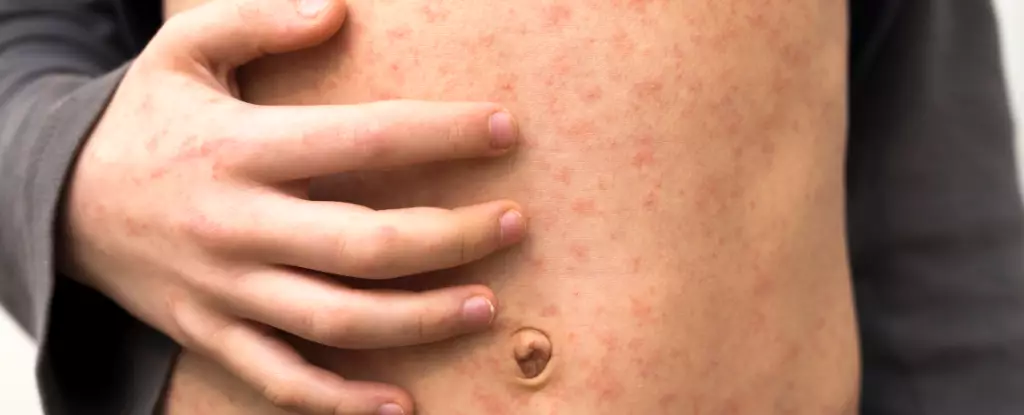The resurgence of measles in the United States is a stark reminder of the vulnerabilities lurking in public health systems that many have come to take for granted. As confirmed cases in Texas reached a staggering 400 and neighboring states like New Mexico and Oklahoma reported over 50 additional cases by late March 2025, health officials are sounding the alarm. Experts suspect that the true number of infections could be significantly higher, indicating a worrying trend that poses a risk to both communal and individual health. The outbreak first ignited in West Texas in late January, and since then, it has rippled across the nation, almost unshackled by our previous triumphs against the disease.
The implications of this resurgence extend beyond the affected regions into the very fabric of public wellbeing. Health authorities have traced potential exposures linked to various modes of transport—from bustling airports like Washington Dulles to crowded Amtrak trains. This accessibility showcases the ease at which measles can traverse geographic and social barriers, shocking reminders that a seemingly eradicated disease should never be underestimated.
The Severity of Measles: A Hidden Threat
The cavalier attitude held by many who dismiss measles as a mere childhood ailment could not be further from the truth. The potential for severe health complications is sobering, and public perception fails to catch up with the evolving reality. While the hospitalization rate for measles dropped to 14% this year, an alarming 40% of infected individuals faced hospitalization last year. Considering that measles leads to serious consequences such as lung damage, immune dysfunction, and neurological impairments, the stakes couldn’t be higher.
It is crucial to highlight that measles is not just an inconvenience; it can be deadly. Statistically, three in every 1,000 infected individuals face fatal outcomes. Those who survive often contend with lifelong ramifications like respiratory issues or impaired neurological function. In particular, pneumonia, a frequent complication, affects one in every 20 children who contract the virus, attesting to the immediate and life-altering impacts of measles.
The Science Behind the Virus
Understanding how measles operates on a biological level adds layers to its threat. The virus demonstrates an impressive ability to infiltrate the body, binding to specific cell surface proteins and hijacking cellular machinery for replication. This ruthless invasion initially occurs in the upper respiratory tract and can spread to the lungs, severely impacting the respiratory system. The process puts significant stress on immune cells, leading to widespread infection and inflammation that can bring about pneumonia and other respiratory diseases.
Moreover, measles’ potential to compromise the immune system is particularly concerning. Beyond the direct impacts of lung damage, the virus can enact devastating changes at the cellular level that are both insidious and long-lasting. Research indicates patients can suffer from depleted immune responsiveness, rendering them vulnerable to other infections—even many they might have previously fought off with ease. It’s a cruel irony; the very virus that sparks such a robust immune response can, paradoxically, weaken future defenses.
Hidden Dangers and Long-Term Consequences
Beyond immediate health risks lies the grim reality of long-term effects from measles, one being the devastating condition known as subacute sclerosing panencephalitis (SSPE). Although rare, this degenerative neurological disease appears in roughly one in 25,000 measles cases and primarily affects children infected before the age of one. Symptoms develop years post-recovery, leading to progressive dementia, and tragically, SSPE outcomes are nearly always fatal. This highlights how immunization not only protects against measles but acts as a safeguard for overall health.
Despite advancements in medical research, such as exploring antibody therapies to treat severe cases, the most straightforward and effective solution remains preventable: vaccination. The two-dose regimen has proved to be 97% effective against the disease, emphasizing its significance in protecting individual and public health.
The Path Forward: Vaccination as a Shield
Complacency due to previous successes against measles is dangerous. Many under the age of 50 have grown up in environments free of the virus, making the gravity of these current outbreaks difficult to appreciate. However, as health experts raise concerns of rising numbers potentially indicating an impending public health crisis, it is imperative that individuals understand the stakes involved.
As more information surfaces and the battle against measles proceeds, it’s crucial to refocus efforts on awareness and education regarding the absolute necessity of vaccinations. In this ongoing fight, the proactive steps taken now could spell the difference between a small outbreak and an epidemic resurgence that could cross the nation. With the stakes as high as they are, it’s time to prioritize action over apathy, protecting not just ourselves but the community at large.


Leave a Reply